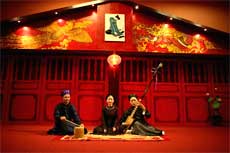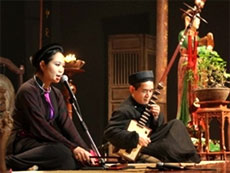The Ministry of Culture, Sports and Tourism on April 16 publicised a national action programme to preserve two UNESCO-recognised forms of Vietnamese folk singing in the 2010-2015 period.

On the day, the two cultural treasures received UNESCO certificates recognising “Quan Ho Bac Ninh†singing (Bac Ninh folk love duets) as an Intangible Cultural Heritage of Humanity and Ca Tru (ceremonial singing) as an Intangible Cultural Heritage in Need of Urgent Safeguarding.
According to the Minister of Culture, Sports and Tourism Hoang Tuan Anh, the action programme will look towards raising the communities’ awareness and capacity in preserving and promoting the unique value of these two cultural treasures.
It will assist Quan Ho and Ca Tru performers not only in performances, but also in sharing experiences with performers of other singing genres in and outside the country, thus enriching their understanding of cultural diversity and ways to protect it.
The ministry plans to systematically compile lists of the songs of the two art forms, both ancient and contemporary, and design communications campaigns to introduce them widely in society so as to draw the people’s attention to conserving these treasures in a sustainable manner.
In the period, the ministry will adopt preferential measures to honour the talented performers who have been greatly devoted to preserving and promoting the values of these intangible heritages, and issue policies encouraging performers to teach youngsters their art.
Also, performers having made significant contributions to the preservation and promotion of Quan Ho Bac Ninh and Ca Tru will be honoured with the titles “The People’s Artist†and “Emeritus Artist†as a way to encourage them to do more to keep these singing genres alive for future generations.
The ministry will formulate programmes to teach the two types of singing in arts schools and at general schools, targeting to train generations of young performers who will help maintain the love duet and ceremonial singing in contemporary life.
The State will also increase investment, along with mobilising funds from various sources in society, for the preservation of the two cultural treasures.
Originating in the northern province of Bac Ninh in around the 13th century, “Quan Ho†is an antiphonal singing tradition in which men and women take turns singing in a call and response pattern.
The love duets combine various elements, including music, lyrics, costumes, and a unique

style of singing that reflects the close relationship between the singers. The rich and diverse tunes and fine lyrics of the songs portray the zest for life and distinctive cultural features of people in the region.
Ca Tru, known as “hat a dao†or “hat noiâ€, dates back to the 15th century. Like many old and highly developed arts, it has many forms. However, the most widely known and widely performed type of Ca Tru involves only three performers: a female vocalist, a lute player and a spectator (who also takes part in the performance).
The female singer provides the vocals whilst playing her “phach†(small wooden sticks beaten on a small bamboo box to serve as percussion). She is accompanied by a man who plays the “dan dayâ€, a long-necked, three-string lute used almost exclusively for the “ca tru†genre.
The last performer is the spectator (often a scholar or connoisseur of the art) who strikes a “trong chau†(praise drum) in praise (or disapproval) of the singer’s performance, usually with every passage of the song. The way in which he strikes the drum provides commentary on the performance, but he always does it according to the beat provided by the vocalist’s “phach†percussion.
Previously, “Nha Nhac Hue†(royal court music) of the Nguyen Dynasty and the Space of “Cong Chieng†(gong) Culture in the Central Highlands were also welcomed by the United Nations Educational, Scientific and Cultural Organisation (UNESCO) as part of the World Intangible Cultural Heritage.